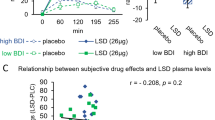Summary
Ninety-six depressed outpatients from 5 centres were given viloxazine 200–400 mg/day. The treatment produced significant clinical improvement as evaluated by the Hamilton Rating Scale for Depression. Thirteen patients dropped-out because of possible side effects. Many untoward symptoms were described by all the patients. To distinguish between illness-related symptoms (IRSs) and potential side effect symptoms (SESs) a new approach was taken, using an algorithm that provides a decision strategy based on the time course both of the symptom and the illness. By this procedure, 90 of the 187 claimed untoward symptoms were identified as IRSs. Of the 97 potential SESs, only 36 were spontaneously volunteered, and the remaining 61 symptoms were elicited on specific questioning. Whenever possible, volunteered potential SESs were assessed to determine the relationship between the drug treatment and the adverse reaction. It was found that only a few instances of gastric disturbance and exacerbation of anxiety were probably violxazine-related.
Similar content being viewed by others
References
Amin MM, Pecknold JC (1978) Nomifensin in the treatment of depression: a standard-controlled clinical study. Psychopharmacol Bull 14: 37–39
Ananth J, Van Den Steen N (1978) A double-blind controlled comparative study of nomifensine in depression. Curr Ther Res 23: 213–221
Åsberg M, Cronholm B, Sjöqvist F, Tuck D (1970) Correlation of subjective side effects with plasma concentrations of nortriptyline. Br Med J 4: 18–21
Coppen A, Ghose K, Montgomery S, Rama Rao VA, Christiansen J, Mikkleson PL, Van Praag HM, Van de Poel F, Minsker EJ, Kozulja VG, Matussek N, Kungkunz G, Jørgensen A (1978) Amitriptyline plasma-concentration and clinical effect. Lancet 1: 63–64
De Wilde J (1977) Double-blind controlled trial of viloxazine hydrochloride and imipramine hydrochloride in the treatment of hospital depressed patients. Acta Ther 3: 49–56
Donald JF (1977) A comparison of high and low dosage regimes of maprotiline (Ludiomil). J Int Med Res 5 [Suppl 4]: 1–10
Ekdawi MY (1971) Dibenzepin and amitriptyline in the treatment of depression. Br J Psychiatr 118: 523–524
Emanueli A, Sacchetti G (1980) An algorithm for the classification of untoward events in large scale clinical trials. Agents Actions [Suppl, Vol 7] Birkhäuser, Basel
Fielding JM (1969) A double-blind comparative trial of dibenzepin and imipramine. Med J Aust 1: 614–616
Floru L, Czarny G, Tegeler J (1976) Double-blind study with the novel antidepressant viloxazine versus imipramine in 50 in-patients. Arzneim Forsch 26: 1170–1171
Gomez Rojo R (1976) Controlled double-blind study of viloxazine and imipramine in depression. Hosp Gen 16: 27–38
Habermann W (1977) A review of controlled studies with nomifensine, performed outside the UK. Br J Clin Pharmacol 4: 237S-241S
Karch FE, Lasagna L (1977) Towards the operational identification of adverse drug reactions. Clin Pharmacol Ther 21: 247–254
Kiloh LG, Bartrop RW, Franklin JA, Neilson MD (1979) A double-blind comparative trial of viloxazine and amitriptyline in patients suffering from endogenous depression. Aust NZ J Psychiatr 13: 357–360
Kramer MS, Leventhal JM, Hutchinson TA, Feinstein AR (1979) An algorithm for the operational assessment of adverse drug reactions. J Am Med Assoc 242: 623–632
Mathew RJ, Weinman M, Claghorn JL (1980) Tricyclic side effects without tricyclics in depression. Psychopharmacol Bull 16: 58–60
McClelland HA, Kerr TA, Little JC (1977) A clinical comparison of nomifensine and amitriptyline. Br J Clin Pharmacol 4: 233S-236S
McMillin WP (1977) A comparison of maprotiline (Ludiomil) and slow release amitriptyline (Tryptizol SR). J Int Med Res 5 [Suppl 4]: 51–58
Murphy JE (1977) A comparison of Ludiomil, Tryptizol and Lentizol. J Int Med Res 5 [Suppl 4]: 34–38
Murphy JE, Bridgman KM (1978) A comparative clinical trial of mianserin (Norval) and amitriptyline in the treatment of depression in general practice. J Int Med Res 6: 199–206
Pinder RM, Brodgen RN, Speight TM, Avery GS (1977) Viloxazine: a review of its pharmacological properties and therapeutic efficacy in depressive illness. Drugs 13: 401–421
Pöldinger W, Gammel G (1978) Differences in effect between nomifensine and nortriptyline. Int Pharmacopsychiatr 13: 58–68
Tsegos IK, Ekdawi MY (1974) A double-blind controlled study of viloxazine and imipramine in depression. Curr Med Res Opin 2: 455–460
Waxman D (1977) The treatment of depression comparing divided and single doses of maprotiline (Ludiomil). J Int Med Res 5 [Suppl 4]: 11–21
Ziegler VE, Taylor JR, Wetzel RD, Biggs JT (1978) Nortriptyline plasma levels and subjective side effects. Br J Psychiatr 132: 55–60
Author information
Authors and Affiliations
Rights and permissions
About this article
Cite this article
Maistrello, I., Grassi, G., Bertolino, A. et al. Unwanted symptoms in depressed patients treated with viloxazine: An algorithm for identification of illness-related symptoms. Eur J Clin Pharmacol 24, 277–281 (1983). https://doi.org/10.1007/BF00613832
Received:
Accepted:
Issue Date:
DOI: https://doi.org/10.1007/BF00613832




